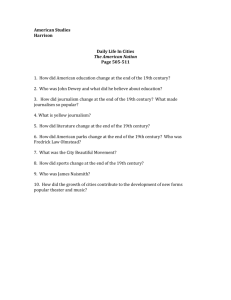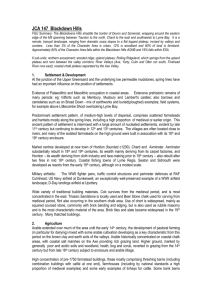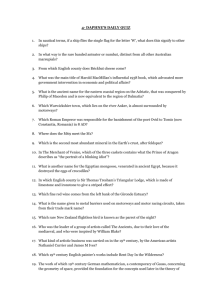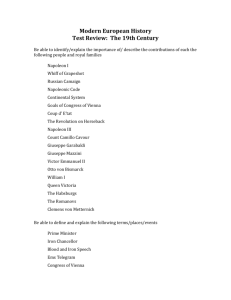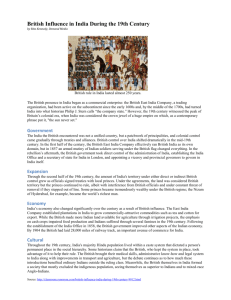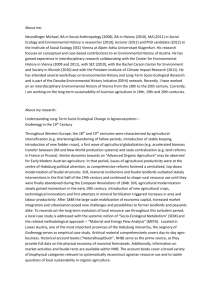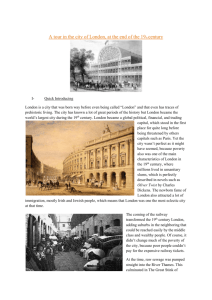JCA 151 South Devon
advertisement
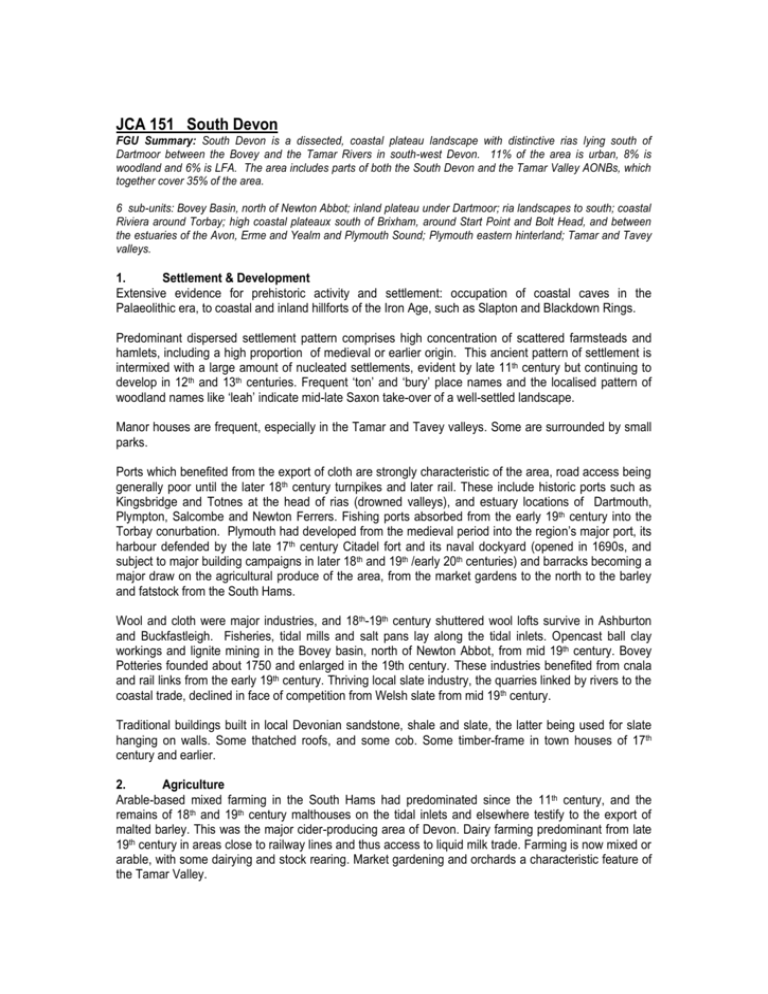
JCA 151 South Devon FGU Summary: South Devon is a dissected, coastal plateau landscape with distinctive rias lying south of Dartmoor between the Bovey and the Tamar Rivers in south-west Devon. 11% of the area is urban, 8% is woodland and 6% is LFA. The area includes parts of both the South Devon and the Tamar Valley AONBs, which together cover 35% of the area. 6 sub-units: Bovey Basin, north of Newton Abbot; inland plateau under Dartmoor; ria landscapes to south; coastal Riviera around Torbay; high coastal plateaux south of Brixham, around Start Point and Bolt Head, and between the estuaries of the Avon, Erme and Yealm and Plymouth Sound; Plymouth eastern hinterland; Tamar and Tavey valleys. 1. Settlement & Development Extensive evidence for prehistoric activity and settlement: occupation of coastal caves in the Palaeolithic era, to coastal and inland hillforts of the Iron Age, such as Slapton and Blackdown Rings. Predominant dispersed settlement pattern comprises high concentration of scattered farmsteads and hamlets, including a high proportion of medieval or earlier origin. This ancient pattern of settlement is intermixed with a large amount of nucleated settlements, evident by late 11th century but continuing to develop in 12th and 13th centuries. Frequent ‘ton’ and ‘bury’ place names and the localised pattern of woodland names like ‘leah’ indicate mid-late Saxon take-over of a well-settled landscape. Manor houses are frequent, especially in the Tamar and Tavey valleys. Some are surrounded by small parks. Ports which benefited from the export of cloth are strongly characteristic of the area, road access being generally poor until the later 18th century turnpikes and later rail. These include historic ports such as Kingsbridge and Totnes at the head of rias (drowned valleys), and estuary locations of Dartmouth, Plympton, Salcombe and Newton Ferrers. Fishing ports absorbed from the early 19th century into the Torbay conurbation. Plymouth had developed from the medieval period into the region’s major port, its harbour defended by the late 17th century Citadel fort and its naval dockyard (opened in 1690s, and subject to major building campaigns in later 18th and 19th /early 20th centuries) and barracks becoming a major draw on the agricultural produce of the area, from the market gardens to the north to the barley and fatstock from the South Hams. Wool and cloth were major industries, and 18th-19th century shuttered wool lofts survive in Ashburton and Buckfastleigh. Fisheries, tidal mills and salt pans lay along the tidal inlets. Opencast ball clay workings and lignite mining in the Bovey basin, north of Newton Abbot, from mid 19th century. Bovey Potteries founded about 1750 and enlarged in the 19th century. These industries benefited from cnala and rail links from the early 19th century. Thriving local slate industry, the quarries linked by rivers to the coastal trade, declined in face of competition from Welsh slate from mid 19th century. Traditional buildings built in local Devonian sandstone, shale and slate, the latter being used for slate hanging on walls. Some thatched roofs, and some cob. Some timber-frame in town houses of 17th century and earlier. 2. Agriculture Arable-based mixed farming in the South Hams had predominated since the 11th century, and the remains of 18th and 19th century malthouses on the tidal inlets and elsewhere testify to the export of malted barley. This was the major cider-producing area of Devon. Dairy farming predominant from late 19th century in areas close to railway lines and thus access to liquid milk trade. Farming is now mixed or arable, with some dairying and stock rearing. Market gardening and orchards a characteristic feature of the Tamar Valley. High concentration of pre-1750 farmstead buildings, these mostly comprising threshing barns (including combination buildings with cattle at one end), farmhouses and some early examples of linhays for cattle. Some bank barns dating from late 18th to mid 19th centuries, many farmsteads having cattle yards for fattening added in the mid-late 19th century. Open-fronted linhays a feature in some areas. Cider houses typically incorporated with stabling and other functions into combination ranges. Field barns of 18th to mid 19th century date a distinctive feature of the South Hams. Some enclosed courtyard plans, mostly on larger and high-status farms: for example on the Duke of Bedford farms near Tavistock, but many also in the South Hams, some as developed or remodelled in the early-mid 19th century with wheel houses for threshing machinery. Dispersed layouts otherwise predominant. 3. Fields and Boundary Patterns Hedgerows and hedgebanks. Farmsteads were sited in villages, in hamlets or individually with access to infield areas ploughed into strip fields, the outfield areas located in large fields or enclosures being subject to intermittent cultivation and sometimes retaining strip fields. Evidence from at least 14th century for piecemeal enclosure, generally complete by 16th century but continuing in South Hams into 17th century, characteristically retaining curved shapes of medieval strips to at least one of the longer sides: these are generally concentrated on valley sides close to settlements. Larger-scale enclosure of this type is also found, representing enclosure at the outset of larger groups of strips, and are particularly characteristic of the South Hams. Some medieval fields – on grange farms (such as at Buckland Abbey) or high-status barton farms - enclosed from the outset, these typically retaining more square forms with generally irregular boundaries, occasionally with post-medieval subdivision within them. Larger fields, the result of both boundary loss and enclosure of late 18th/19th centuries, on high, flatter land and high coastal plateaux. 4. Trees and Woodland There are few hedgerow trees near the coast. Substantial areas of ancient woodland, eg to valleys cut into inland plateau. 5. Semi-Natural Environments 6. River and Coastal Features Railway engineering works: viaducts and bridges of I K Brunel’s South Devon Railway, including the stone piers that took timber superstructures; Royal Albert Bridge (1859) over the Tamar. Pillboxes still mark the location of the WWII defended area along the shoreline at Hollicombe Beach, north of Paignton, in a landscape setting which has changed comparatively little over time. Castles, blockhouses and batteries reflecting advances in military technology from the medieval period to the early 20th century along Plymouth Sound and the Dart estuary in particular -notable examples including Dartmouth Castle, and the opposite blockhouse at Bayards Cove Castle, 19th Laira Battery, or Efford Fort and battery, Plymouth; Berry Head Fort and the Old Redoubt, Torbay. D-Day embarkation slipways in the area’s inlets and creeks, and the D-Day embarkation harbour (the most substantial relating to the landings) at Toquay. Masonry bridges are part of the two main concentrations of medieval-18th century bridges in England (Devon and Cornwall, and north and west Yorkshire). Highly prominent late prehistoric defended settlements and enclosures along the coastal headlands - eg Bolt Tail Camp and Oldaport Camp around Bigbury Bay.
